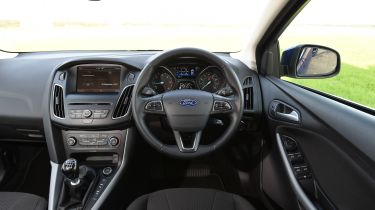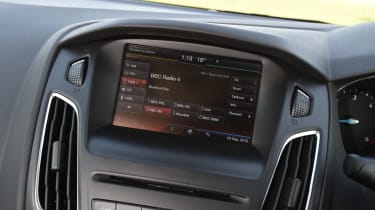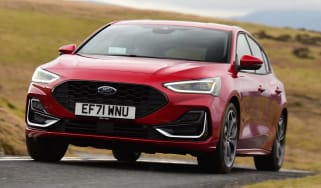Used Ford Focus review: 2011 to 2018 (Mk3) - Interior, comfort and safety
The third-generation Ford Focus is comfortable on bumpy roads but the interior looks a bit dated
All versions of the Ford Focus are comfortable, with nicely padded seats and a decent range of wheel and seat adjustment for the driver. The highest-spec cars have heated leather seats, but we think they’re only slightly more comfortable than the regular seats and perhaps not worth the significant extra cost.
While the ride is smooth, when the biggest wheels are fitted it does get a little more uncomfortable, so the highest-spec models aren’t as appealing as they might seem at first, but you can always swap the wheels and tyres at a later date if needed. The interior feels a bit dated in all models, which isn’t something that can be sorted easily.
What’s the Ford Focus like inside?
The Ford Focus has a well built interior and was given a real lift after the 2014 facelift. Still, it’s a relentlessly grey environment, though the materials on top of the dashboard and around the major controls are soft and feel good. But the plastics lower down in the footwells and on the doors feel harder and of lower quality.
All-round visibility is average, with thin window pillars contributing to a good view of the road ahead but a relatively small rear window and thicker rear pillars mean the view out the back could be better.
More reviews
In front of the driver are two dials separated by the trip-computer display, which in higher-spec models is operated with buttons on a multifunction steering wheel. These sculpted buttons are neatly styled and easy to use.
What’s on the equipment list?
In 2011-2014 models, the trim range was fairly small. Focus Zetec has air-conditioning and Bluetooth phone connectivity and the Zetec S adds uprated sports suspension and a sporty bodykit. Sat-nav is added on the Zetec Navigator model, and the top of the range was the Ford Focus Titanium, which features automatic lights and wipers and a multimedia infotainment system.
Later cars from 2014 on are much better equipped. The entry-level Style trim has air-con, electric front windows and mirrors and a tyre-pressure-monitoring system. You need to step up to Zetec for Ford's 'Quickclear' heated front windscreen, alloy wheels and Ford’s SYNC3 infotainment system with Apple CarPlay and Android Auto connectivity.
Our favourite model is the Titanium, which adds luxuries such as automatic headlights and wipers, rear parking sensors, Active City Stop autonomous braking, dual-zone climate control and cruise control. Titanium X trim comes with xenon headlights, active parking assistance, power-folding mirrors, ambient interior lighting, part-leather heated seats and a parking camera.
If you want the look of the Ford Focus ST, but without the extra performance and increased running costs that come with it, then you could also go for the ST-Line model. This has an eye-catching bodykit, sports seats and special 17-inch alloy wheels to give the look and feel of the hot-hatchback version, without the big engine.
These sporty accessories came at the expense of other kit, such as parking sensors, electric rear windows, heated seats and automatic lights and wipers, although the first owners may have added them back as options. Also be aware that the ST-Line model also has lowered sports suspension, which is firmer than the standard set-up.
An option to look out for is an 8.8-inch upgrade to the infotainment system, which adds a pinch-to-zoom sat-nav map and app connectivity. A premium version of this system was also available with Sony speakers.
How safe is it?
The Focus earned the maximum five-star rating in its Euro NCAP crash safety tests, with impressive ratings in the adult occupant category and a decent 71 per cent for safety assist, because it’s well equipped with helpful assistance tech.
The focus comes with a full complement of front, side and curtain airbags, lane-departure warning and a driver-tiredness monitor as standard. Models from Titanium upwards also have autonomous emergency braking, which can bring the car to a safe halt if it detects an obstacle in its path.














